Unit4 Where's my school bag 教案
- 格式:doc
- 大小:59.50 KB
- 文档页数:5
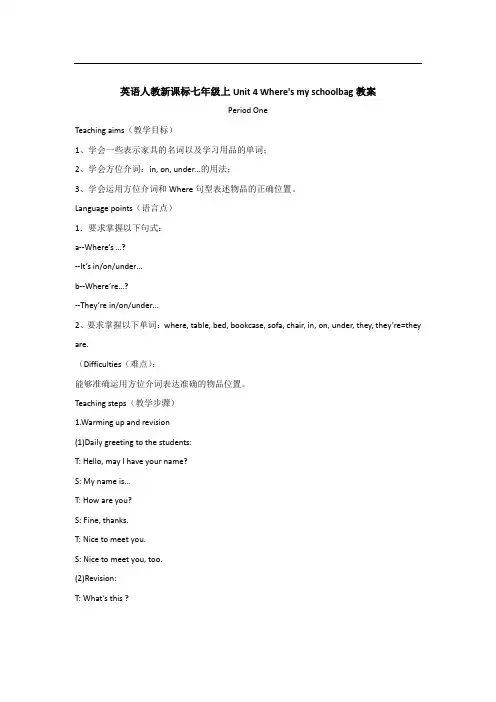
英语人教新课标七年级上Unit 4 Where's my schoolbag教案Period OneTeaching aims(教学目标)1、学会一些表示家具的名词以及学习用品的单词;2、学会方位介词:in, on, under…的用法;3、学会运用方位介词和Where句型表述物品的正确位置。
Language points(语言点)1.要求掌握以下句式:a--Where’s …?--It’s in/on/under…b--Where’re…?--They’re in/on/under…2、要求掌握以下单词:where, table, bed, bookcase, sofa, chair, in, on, under, they, they’re=they are.(Difficulties(难点):能够准确运用方位介词表达准确的物品位置。
Teaching steps(教学步骤)1.Warming up and revision(1)Daily greeting to the students:T: Hello, may I have your name?S: My n ame is…T: How are you?S: Fine, thanks.T: Nice to meet you.S: Nice to meet you, too.(2)Revision:T: What’s this ?S: It’s a pen.T: How do you spell it?S: P-E-N, pen.T: What color is it?S: It’s red.T: Good. Next, what’s that ?S: …2. Presentation(呈现新知识)Show the students a picture of a room, tell them this is a bedroom, let the students list the things in it first. Then show them the whole picture, teach the new words, ask where the things are, let the students answer, using the prepositions. 在新单词的教学过程中,一些有能力的学生可以将自己已有的认识水平与实际运用结合起来,使他们能体会到通过自主学习带来成功的满足感。
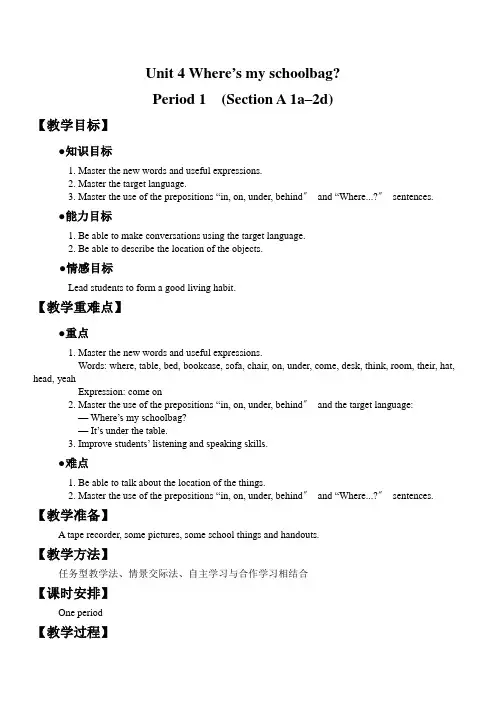
Unit 4 Where’s my schoolbag?Period 1 (Section A 1a–2d)【教学目标】●知识目标1. Master the new words and useful expressions.2. Master the target language.3. Master the use of the prepositions “in, on, under, behind〞and “Where...?〞sentences.●能力目标1. Be able to make conversations using the target language.2. Be able to describe the location of the objects.●情感目标Lead students to form a good living habit.【教学重难点】●重点1. Master the new words and useful expressions.Words: where, table, bed, bookcase, sofa, chair, on, under, come, desk, think, room, their, hat, head, yeahExpression: come on2. Master the use of the prepositions “in, on, under, behind〞and the target language:—Where’s my schoolbag?—It’s under the table.3. Improve students’ listening and speaking skills.●难点1. Be able to talk about the location of the things.2. Master the use of the prepositions “in, on, under, behind〞and “Where...?〞sentences. 【教学准备】A tape recorder, some pictures, some school things and handouts.【教学方法】任务型教学法、情景交际法、自主学习与合作学习相结合【课时安排】One period【教学过程】Step 1: Greetings and revisions1. Greeting the students.T: Good morning! /Hello!/ Hi! ...Ss: Good morning! /Hello!/ Hi! ...2. RevisionT: What’s this in English?S1: Can you spell it?T: Yes, thank you. You are very good. What are these in English?S2: They are keys.T: Can you spell it?S: Yes, K-E-Y-S, keys.Step 2: Lead-inT: Last week, we finished Unit 3. Today we are going to study a new unit, Unit 4.Ask and answerT: Can you tell me what the title of Unit 4 is? Yes, it’s “Where’s my schoolbag?〞What do you think the unit is about?T: Great! In this unit, we are going to learn to talk about where things are. Do you still remember some school things we have learned?T: What are they? OK. Let’s start to talk about some school things first.Step 3: Presentation1. Teach activity 1aT: First, please open your books to page 19 and look at activity 1a.(1) Look and findT: Please look at the picture in activity 1a. There are some things in it. Do you know what they are?(2) Match and discussT: Would you please match the words with the things in the picture?T: How many words do you know? Can you share the words you know with your partners?T: Please discuss with your partners and check whether your answers are the same.(3) Check the answersT: Let’s check the answers together.Answers: 1.table b 2.bed e 3.bookcase h 4.sofa g 5.chair d 6.schoolbag a 7.books f 8.keys c(4) ReadFirst, ask students to read the words after the teacher. Read each word twice then ask students to read the words one by one together.2. Teach activity 1b(1) Ask students to listen to the recording for the first time. Students number the things in the picture when you listen.(2) Play the recording for the second time. Ask students to write answers by themselves.(3) Invite some students to check the answers. Then play the recording for the third time. Havestudents listen and repeat, pay attention to the pronunciation and intonation.Answers: 1.books 2.pencil box 3.computer game 4.keys3. Teach activity 1c(1) Lead students to read the conversations in 1a. Ask them to pay attention to the pronunciation and intonation.(2) Explain the languages points in the conversations.(3) Ask students to read the sample conversation in 1c. Encourage them to make their own conversations using the given words in the box.(4) Leave them several minutes to do this task in pairs.(5) Invite some pairs to act out their conversations for the whole class.Step 4: Practice1. Teach activities 2a(1) Go through the instruction in 2a with the class.(2) Look at the pictures in 2a.(3) Play the recording for the first time. Students listen and number the things.(4) Play the recording for the second time. Let students check the questions they hear, then check the answers.Answers: 2.books 6.keys 1.computer game 5.ruler 3. pencil box 4.schoolbag2. Teach activities 2b(1) Go through the instruction in 2b with the class.(2) Look at the pictures in 2b carefully.(3) Play the recording for the first time and tell students to only listen to them carefully.(4) Play the recording for the second time. Ask students to find the things in 2a and number them in the picture.Ask them to do it individually.(5) Then check the answers.Answers: 1.computer game in the bookcase2.books on the chair3.pencil box under the sofa4.schoolbag under the table5.ruler under the chair6.keys on the table(6) Play the recording for the third time. And let students listen and repeat.3. Teach activity 2c(1) Ask the students to read through the conversations in pairs.(2) Give them three minutes to practice reading it.As students work, walk around the room, offering help if necessary. Correct pronunciation mistakes if any.(3) Ask several pairs to act out their conversations.Step 5: ConsolidationTeach activity 2d1. Ask students to read the conversation by themselves to get the main idea.2. Lead students to read the conversation sentence by sentence, and explain some languagepoints at the same time.3. Play the recording, and ask students to listen and repeat. Then ask them to role-play theconversation in pairs. Move around the classroom to check the progress.4. Invite several pairs to role-play the conversation for the whole class.【课堂小结】In this period, we’ve learned how to talk about the location of things through some listening and speaking practice. And we’ve also learned the use of “Where...?〞question and the prepositions of location.【课后作业】1. Review the new words and useful expressions in this period.2. Practice the conversation in 2d in pairs and recite it.3. Finish the exercises in the workbook.4. Preview the next period.。
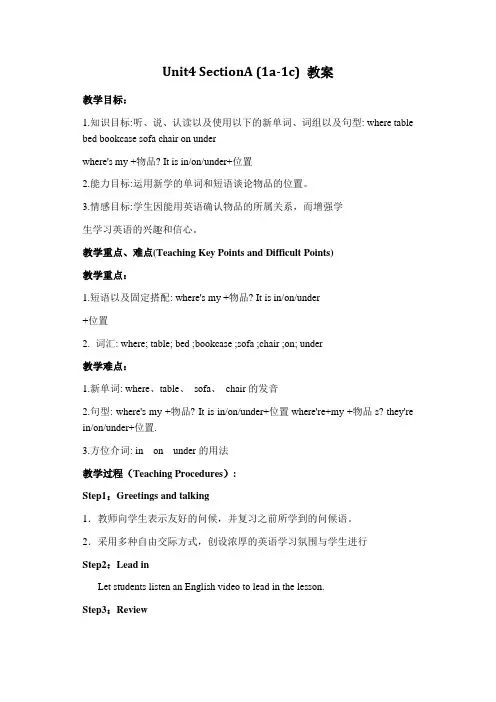
Unit4 SectionA (1a-1c) 教案教学目标:1.知识目标:听、说、认读以及使用以下的新单词、词组以及句型: where table bed bookcase sofa chair on underwhere's my +物品? It is in/on/under+位置2.能力目标:运用新学的单词和短语谈论物品的位置。
3.情感目标:学生因能用英语确认物品的所属关系,而增强学生学习英语的兴趣和信心。
教学重点、难点(Teaching Key Points and Difficult Points)教学重点:1.短语以及固定搭配: where's my +物品? It is in/on/under+位置2.词汇: where; table; bed ;bookcase ;sofa ;chair ;on; under教学难点:1.新单词: where、table、sofa、chair的发音2.句型: where's my +物品? It is in/on/under+位置where're+my +物品s? they're in/on/under+位置.3.方位介词: in on under的用法教学过程(Teaching Procedures):Step1:Greetings and talking1.教师向学生表示友好的问候,并复习之前所学到的问候语。
2.采用多种自由交际方式,创设浓厚的英语学习氛围与学生进行Step2:Lead inLet students listen an English video to lead in the lesson.Step3:ReviewShow some pictures and let students do “Look and say” to review the sentences:A: What’s this?B: It's a/an... .A: What are these?B: They’re... .Step4:Presentation1.Learn the new words.2. Show some pictures to learn new words.3.Look and fill in the blanksLet students “Match the words with the things in the picture “ in 1a4.学习方位介词:in on under5.Look and say师生互动操练新句型:A:Where is the pencil?B: It’s in the pencil box.A:Where’s the eraser?B: It’s in the pencil box.6.Pair work让学生生生活动练习句型:A:Where’s the...?B:It’s in/ on/ under....7.Look and say展示图片进行师生互动操练新句型:A:Where are the ...s?B: They are in /on/under the ... .8.pair work让学生生生活动练习句型:A:Where are the…s?B:They are in/ on/ under ... .8.ListeningLet student listen to 1b (Listen and number the things in the picture[1-4].)9.Summary师生一起回顾:1.本节课学习的生词:table bed bookcase sofa chair2.重点句型:Where is …? ……在哪?It’s in / on / under … 它在…里面/上面/下面。
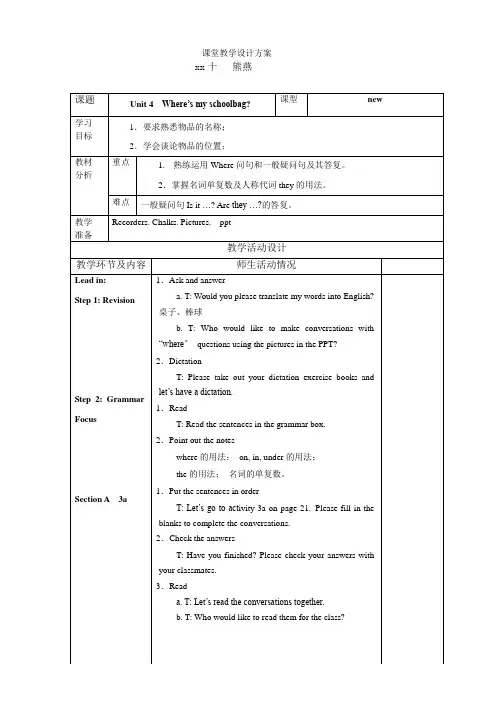
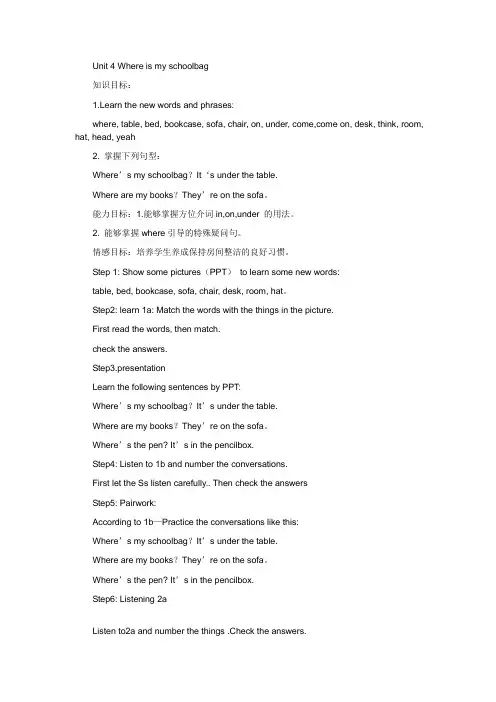
Unit 4 Where is my schoolbag知识目标:1.Learn the new words and phrases:where, table, bed, bookcase, sofa, chair, on, under, come,come on, desk, think, room, hat, head, yeah2. 掌握下列句型:Where’s my schoolbag?It‘s under the table.Where are my books?They’re on the sofa。
能力目标:1.能够掌握方位介词in,on,under 的用法。
2. 能够掌握where引导的特殊疑问句。
情感目标:培养学生养成保持房间整洁的良好习惯。
Step 1: Show some pictures(PPT)to learn some new words:table, bed, bookcase, sofa, chair, desk, room, hat。
Step2: learn 1a: Match the words with the things in the picture.First read the words, then match.check the answers.Step3.presentationLearn the following sentences by PPT:Where’s my schoolbag?It’s under the table.Where are my books?They’re on the sofa。
Where’s the pen? It’s in the pencilbox.Step4: Listen to 1b and number the conversations.First let the Ss listen carefully.. Then check the answersStep5: Pairwork:According to 1b—Practice the conversations like this:Where’s my schoolbag?It’s under the table.Where are my books?They’re on the sofa。
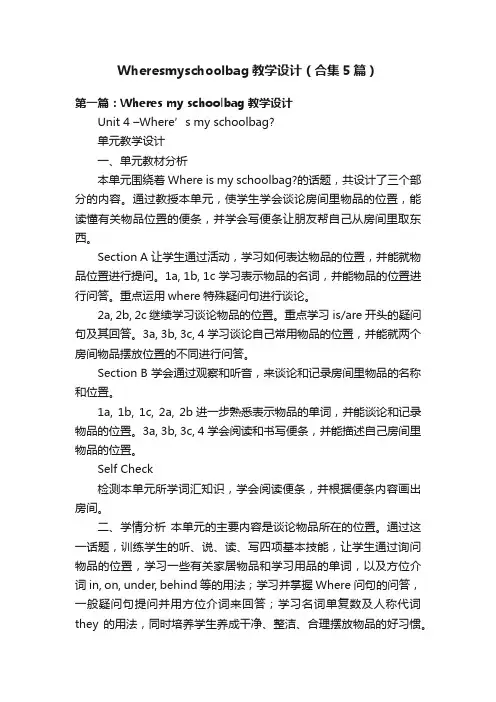
Wheresmyschoolbag教学设计(合集5篇)第一篇:Wheres my schoolbag教学设计Unit 4 –Where’s my schoolbag?单元教学设计一、单元教材分析本单元围绕着Where is my schoolbag?的话题,共设计了三个部分的内容。
通过教授本单元,使学生学会谈论房间里物品的位置,能读懂有关物品位置的便条,并学会写便条让朋友帮自己从房间里取东西。
Section A 让学生通过活动,学习如何表达物品的位置,并能就物品位置进行提问。
1a, 1b, 1c 学习表示物品的名词,并能物品的位置进行问答。
重点运用where特殊疑问句进行谈论。
2a, 2b, 2c 继续学习谈论物品的位置。
重点学习is/are开头的疑问句及其回答。
3a, 3b, 3c, 4 学习谈论自己常用物品的位置,并能就两个房间物品摆放位置的不同进行问答。
Section B 学会通过观察和听音,来谈论和记录房间里物品的名称和位置。
1a, 1b, 1c, 2a, 2b进一步熟悉表示物品的单词,并能谈论和记录物品的位置。
3a, 3b, 3c, 4 学会阅读和书写便条,并能描述自己房间里物品的位置。
Self Check检测本单元所学词汇知识,学会阅读便条,并根据便条内容画出房间。
二、学情分析本单元的主要内容是谈论物品所在的位置。
通过这一话题,训练学生的听、说、读、写四项基本技能,让学生通过询问物品的位置,学习一些有关家居物品和学习用品的单词,以及方位介词in, on, under, behind 等的用法;学习并掌握Where问句的问答,一般疑问句提问并用方位介词来回答;学习名词单复数及人称代词they 的用法,同时培养学生养成干净、整洁、合理摆放物品的好习惯。
三、单元教学目标1、Vocabulary Rooms of the house, furniture, table, bed, sofa, chair, desk, Where questions Prepositions: on, in, under2、Target Language(目标语言)Where is his pencil? It is in his schoolbag.Where’s your ruler? It’s under the chair.Where are my books? They’re on the sofa.3、Skills(技能)Listening and read for specific information课时教学设计首页一、课时教学目标1.掌握有关物品的名称table, bed, dresser, bookcase, sofa, chair, drawer, plant, bag, alarm clock, CD, video, video cassette, hat, etc;2.学会谈论物品的位置。
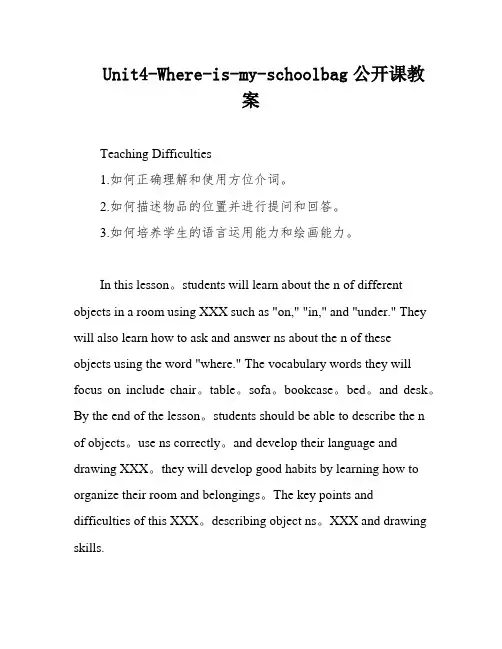
Unit4-Where-is-my-schoolbag公开课教案Teaching Difficulties1.如何正确理解和使用方位介词。
2.如何描述物品的位置并进行提问和回答。
3.如何培养学生的语言运用能力和绘画能力。
In this lesson。
students will learn about the n of different objects in a room using XXX such as "on," "in," and "under." They will also learn how to ask and answer ns about the n of these objects using the word "where." The vocabulary words they will focus on include chair。
table。
sofa。
bookcase。
bed。
and desk。
By the end of the lesson。
students should be able to describe the n of objects。
use ns correctly。
and develop their language and drawing XXX。
they will develop good habits by learning how to organize their room and belongings。
The key points and difficulties of this XXX。
describing object ns。
XXX and drawing skills.under with the help of pictures and a video。
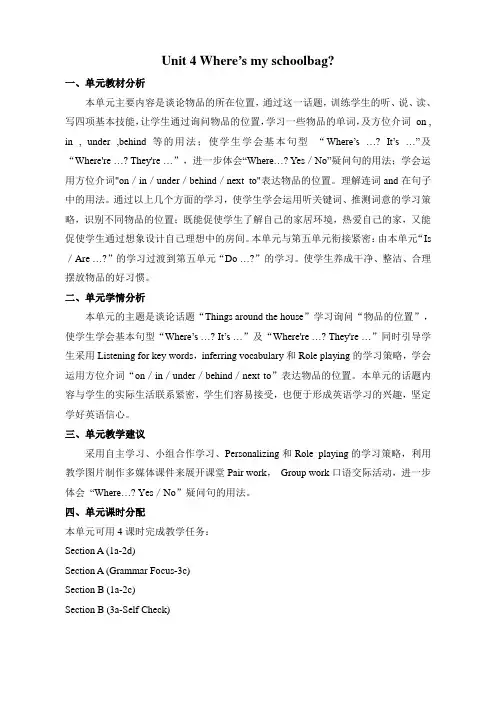
Unit 4 Where’s my schoolbag?一、单元教材分析本单元主要内容是谈论物品的所在位置,通过这一话题,训练学生的听、说、读、写四项基本技能,让学生通过询问物品的位置,学习一些物品的单词,及方位介词on , in , under ,behind 等的用法;使学生学会基本句型“Where’s …? It’s …”及“Where're …? They're …”,进一步体会“Where…? Yes/No”疑问句的用法;学会运用方位介词"on/in/under/behind/next to"表达物品的位置。
理解连词and在句子中的用法。
通过以上几个方面的学习,使学生学会运用听关键词、推测词意的学习策略,识别不同物品的位置;既能促使学生了解自己的家居环境,热爱自己的家,又能促使学生通过想象设计自己理想中的房间。
本单元与第五单元衔接紧密:由本单元“Is /Are …?”的学习过渡到第五单元“Do …?”的学习。
使学生养成干净、整洁、合理摆放物品的好习惯。
二、单元学情分析本单元的主题是谈论话题“Things around the house”学习询问“物品的位置”,使学生学会基本句型“Wher e’s …? It’s …”及“Where're …? They're …”同时引导学生采用Listening for key words,inferring vocabulary和Role playing的学习策略,学会运用方位介词“on/in/under/behind/next to”表达物品的位置。
本单元的话题内容与学生的实际生活联系紧密,学生们容易接受,也便于形成英语学习的兴趣,坚定学好英语信心。
三、单元教学建议采用自主学习、小组合作学习、Personalizing和Role playing的学习策略,利用教学图片制作多媒体课件来展开课堂Pair work,Group work口语交际活动,进一步体会“Where…? Yes/No”疑问句的用法。

Unit 4 Where’s my schoolbag?Period 1Teaching aims:1. Language goals:Key vocabulary: table, bed, bookcase, sofa, chair, where, on, under.Target language: Where’s my schoolbag? It’s under the table.Where are my books? They’re on the sof a2. Ability goalsTalk about where things are, Learn the using of preposition “ on, in, under”Train the students’ communicative competence.3. Moral goalsKeep your room and tidy.Teaching important points:1. New words.2. How to talk about where things are, Learn the using of preposition “ on, in,under”Teaching difficult points:1. Prepositions of place: in, on, under.2. Prepositional phrases: on the sofa, under the bed, etc.Period 2Teaching aims:1. Language goals:Key vocabulary: table, bed, bookcase, sofa, chair, where, on, under.Target language: Where’s the map? It’s in your grandparents’ room.Where are my books? They’re on the sofa.Where’s the baseball?Is it on the table? No, it isn’t.Is it under the table? Yes, it is.A: Where’re the keys? Are they under the table?B: No, t hey aren’t. They are on the table.2. Ability goalsTalk about where things are, Learn the using of preposition “ on, in, under”Train the students’ communicative competence.Listening an speaking skills.3. Moral goals Keep your room and tidy.Teaching important points:1. Target language.2. Talk about where things are, Learn the using of preposition “ on, in, under”3. 一般疑问句的简短回答。
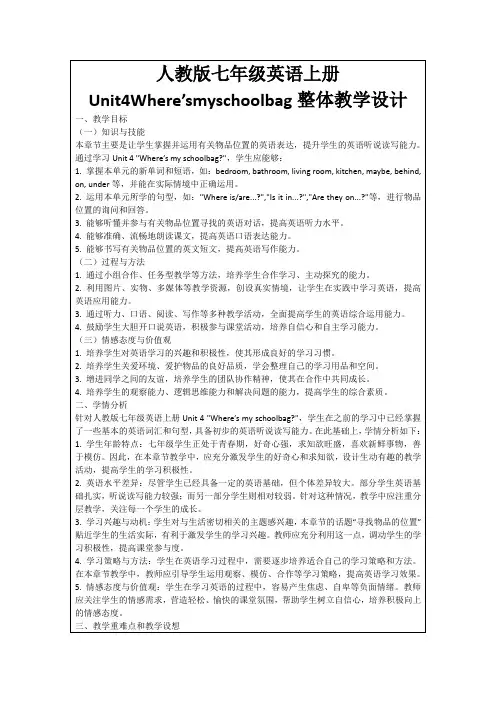
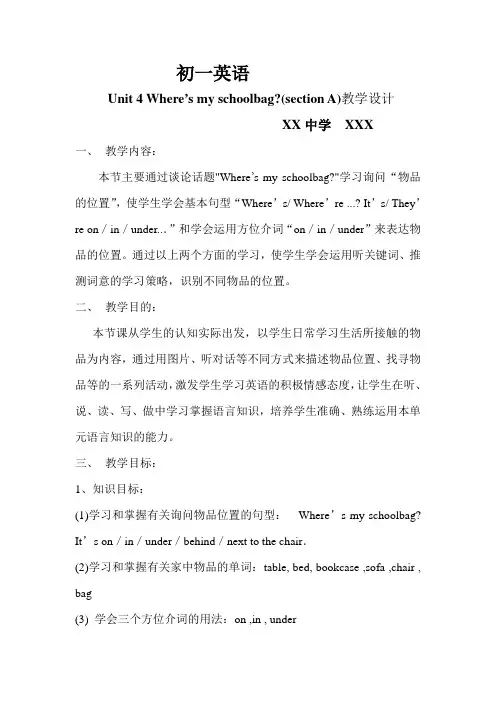
初一英语Unit 4 Where’s my schoolbag?(section A)教学设计XX中学XXX一、教学内容:本节主要通过谈论话题"Where’s my schoolbag?"学习询问“物品的位置”,使学生学会基本句型“Where’s/ Where’re ...? It’s/ They’re on/in/under...”和学会运用方位介词“on/in/under”来表达物品的位置。
通过以上两个方面的学习,使学生学会运用听关键词、推测词意的学习策略,识别不同物品的位置。
二、教学目的:本节课从学生的认知实际出发,以学生日常学习生活所接触的物品为内容,通过用图片、听对话等不同方式来描述物品位置、找寻物品等的一系列活动,激发学生学习英语的积极情感态度,让学生在听、说、读、写、做中学习掌握语言知识,培养学生准确、熟练运用本单元语言知识的能力。
三、教学目标:1、知识目标:(1)学习和掌握有关询问物品位置的句型:Where’s my schoolbag? It’s on/in/under/behind/next to the chair.(2)学习和掌握有关家中物品的单词:table, bed, bookcase ,sofa ,chair , bag(3) 学会三个方位介词的用法:on ,in , under2、能力目标:培养学生用英语思维的判辨能力、综合运用语言的能力和自主学习的能力。
培养学生的语言交际能力和创新能力。
3、情感目标:提高学生学习英语的兴趣和自信心,培养学生善于与他人合作的精神,使他们积极主动参预课堂活动和相关的课外活动,并从中体验学习的乐趣,从而培养学生乐于探索和勤于动手的学习态度。
4、德育目标:促使学生了解和关心自己和他人的家居环境,热爱自己的家,养成良好的生活习惯。
从完成任务的过程中,学会互相合作,互相帮助,互相提高的社会交际意识。
四、教学重、难点:掌握句型:Where’s my schoolbag? It’s on/in/under the chair.学习运用重点句型"Where is/Where are…? 学会运用方位介词"on/in/under”表达物品的位置。
Unit 4 Where’s my schoolbag?一、教学目标1.学习一些有关家具物品和学习用品的单词2.运用方位借此表述物体位置3.掌握where问句的回答、一般疑问句提问并用方位介词回答4.学习名词单复数及人称代词they的用法二、能力目标1.学会正确描述物品作在的位置;2.学会询问自己或他人物品的具体位置;3.能够合理地描述和设计房间。
三、情感目标培养学生整齐地摆放自己物品的生活习惯。
四、语言目标1.词汇: Rooms of the house, furniture, table, bed, sofa, chair, desk, radio, clock, tape, tape player, model plane, on, under, where, their, Come on2.句型:Where is his pencil?It is in his schoolbag.Where’s your ruler?It’s under the chair.Where are my books?They’re on the sofa.五、教学重点:1.方位借此in, on, under, behind, in front of, near等的用法2.where的特殊疑问句和一般疑问句Is the…in/on/under…?的肯定、否定回答。
3.新单词: bed, dresser, table, bookcase, backpack…六、教学难点:1.能够准确运用方位借此描述物品所在的位置2.能够运用where问句找到物品的位置。
七、课时安排The 1st period (第一课时): Section A (1a –2d)The 2nd period (第二课时): Section A (Grammar focus – 3c)The 3rd period (第三课时): Section B (1a- 1e)The 4th period (第四课时): Section B (2a- 2c )The 5th period (第五课时): Section B (3a- Self Check )The 1st period (第一课时): Section A (1a –2d)Teaching aims(教学目标)1. 掌握有关物品的名称table, bed, dresser, bookcase, sofa, chair, drawer, plant, bag, alarm clock, CD, video, video cassette, hat, etc;2. 学会谈论物品的位置。
Unit 4 Where is my schoolbag? 教学设计xx中学xxx一、教学内容本单元以谈论物品位置(Things around the house)为话题,要求学生学会方位介词on, in, under, behind等的用法。
题材颇具现代气息,贴近学生日常生活,内容丰富,词汇量大,通过描述物品位置、找寻物品、设置理想化居室等系列活动,让学生在听、说、读、写、做中学习语言知识,培养运用语言知识的能力,激发创新精神。
而本节课在这个单元中对于物品方位的初步认知和表达起着重要的作用,主要通过问答方式教授学生如何表达单复数物品简单的方位。
二、语言结构1.句型:Where is/are …?It is/They are ….2. 方位介词on, in, under, behind等的用法3. 名词的复数形式三、教学重点、难点1. 方位介词in, on, under behind的用法2.Where的特殊疑问句及其回答。
3.新单词bed, table, bookcase…四、单元教学目标1.知识目标(1)掌握新单词(2)熟练运用介词in, on, under(3)熟练运用where问句及其回答(4)掌握名词单复数及人称代词they的用法2.能力目标(1)学会用英语询问自己的和他人的物品的具体位置(2)学会用英语准确描述物品的具体位置3.情感目标(1)培养学生整齐摆放自己物品的生活习惯(2)通过小组对话、讨论等一系列的课堂活动,培养学生的合作精神五、教学方法和学习策略(1)交际策略: 学会与他人合作交流,并能把语言材料用到真实的生活中去(2)资源策略:学会利用一切可利用的学习资源如词典,书等来获取更多的学习信息六、课时安排六课时七、教学过程设计Period 1I. 教学目标1. 知识目标1)单词:Bedroom bed(s) schoolbag sitting room table chairs sofa table chairs books bookcase2)句型: Where is/are …?It is/They are ….2.能力目标Use English to talk about the position of thingsII. 教学重点掌握重点单词和询问物品的位置III. 教学难点1.正确使用介词in on under behind2.名词的单复数变化及谓语动词的变化IV. 教学设计Step1. Lead-inPlay the flash and have students sing along with it. Tell them to clap their hands if they would like to.Step2. Learn the new wordsShow the pictures of furniture, learn the new words.T: What is this?Ss: It is a …Step3. GuessShow a picture of box,and ask students to guess: Where is the cat?If they have correct answers. Encourage them.Step4. PresentationShow a picture of room, have students use the target language to make a dialogue.For example:T: Where is my schoolbag?S: It’s on the table2.S: Where’s my pencil?S:It’s in the schoolbag3. T: Where are my keys ?S: They’re on the chair(红色的地方老师要强调,单数要用is复数要用are) Step 5. Finish 1aHave students read these words again and finish 1a. Match the words with the pictures.(Keys: b e h g d a, f c)Step 6. 听力练习1b.Listen carefully and number the things in the picture 1-4. Check the answers. Step 7. Summary and HomeworkThis class we talk about where things are, everyone has a good job, after class, please talk about them with your family members. Don’t forgetyou’re your things in a correct order.Step 8: Blackboard designUnit4 Where is my school bag?Section A 1a-1c1 Key vocabulary: where 、table、bed 、chair、on under、bookcase、sofa2 Target languageWhere‘s the/my …? (Where‘s=Where is)It’s/ on/in/under the ….Where are the/my …?They’re on/in/under the …. (They’re=They are) 3.区分:cat bat mat hatUnit 4 Where is my schoolbag? 教学设计一、教学内容本单元以谈论物品位置(Things around the house)为话题,要求学生学会方位介词on, in, under, behind等的用法。